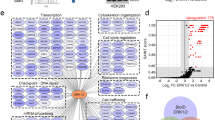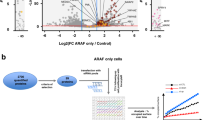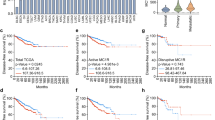Abstract
Melanocytes use BRAF to activate the MAP kinase (MAPK) pathway because CRAF is inhibited by the cyclic AMP (cAMP) pathway in these cells. By contrast, melanomas harboring Ras mutations use CRAF to activate the MAPK pathway. We describe the molecular mechanism of Raf isoform switching and cAMP pathway disruption, which take place during melanocyte transformation. We show that overactivation of the MAPK pathway, induced by the oncogenic Ras in melanoma, induces constitutive phosphorylation of BRAF on Ser151 by ERK, which inhibits NRAS-BRAF interaction . We also demonstrate that melanoma cells have elevated cAMP phosphodiesterase activity owing to overexpression of the cAMP-specific phosphodiesterase-4 enzymes; this activity inhibits cAMP signaling and allows CRAF reactivation in these cells. Reactivating the cAMP pathway inhibits proliferation and induces apoptosis of Ras-mutated melanoma cells, suggesting a new therapeutic approach for treating melanomas harboring Ras mutations.
This is a preview of subscription content, access via your institution
Access options
Subscribe to this journal
Receive 12 print issues and online access
$189.00 per year
only $15.75 per issue
Buy this article
- Purchase on Springer Link
- Instant access to full article PDF
Prices may be subject to local taxes which are calculated during checkout







Similar content being viewed by others
References
MacKie, R.M., Hauschild, A. & Eggermont, A.M. Epidemiology of invasive cutaneous melanoma. Ann. Oncol. 20 Suppl 6, vi1–vi7 (2009).
Hirobe, T. Role of keratinocyte-derived factors involved in regulating the proliferation and differentiation of mammalian epidermal melanocytes. Pigment Cell Res. 18, 2–12 (2005).
Dumaz, N. & Marais, R. Integrating signals between cAMP and the RAS/RAF/MEK/ERK signalling pathways. Based on the anniversary prize of the Gesellschaft fur Biochemie und Molekularbiologie Lecture delivered on 5 July 2003 at the Special FEBS Meeting in Brussels. FEBS J. 272, 3491–3504 (2005).
McKay, M.M. & Morrison, D.K. Integrating signals from RTKs to ERK/MAPK. Oncogene 26, 3113–3121 (2007).
Karnoub, A.E. & Weinberg, R.A. Ras oncogenes: split personalities. Nat. Rev. Mol. Cell Biol. 9, 517–531 (2008).
Wellbrock, C., Karasarides, M. & Marais, R. The RAF proteins take centre stage. Nat. Rev. Mol. Cell Biol. 5, 875–885 (2004).
Turjanski, A.G., Vaque, J.P. & Gutkind, J.S. MAP kinases and the control of nuclear events. Oncogene 26, 3240–3253 (2007).
Cohen, C. et al. Mitogen-actived protein kinase activation is an early event in melanoma progression. Clin. Cancer Res. 8, 3728–3733 (2002).
Satzger, I. et al. Anal mucosal melanoma with KIT-activating mutation and response to imatinib therapy—case report and review of the literature. Dermatology 220, 77–81 (2010).
Monsel, G., Ortonne, N., Bagot, M., Bensussan, A. & Dumaz, N. c-Kit mutants require hypoxia-inducible factor 1α to transform melanocytes. Oncogene 29, 227–236 (2010).
Brose, M.S. et al. BRAF and RAS mutations in human lung cancer and melanoma. Cancer Res. 62, 6997–7000 (2002).
Davies, H. et al. Mutations of the BRAF gene in human cancer. Nature 417, 949–954 (2002).
Garnett, M.J. & Marais, R. Guilty as charged; B-RAF is a human oncogene. Cancer Cell 6, 313–319 (2004).
Wellbrock, C. et al. V599EB-RAF is an oncogene in melanocytes. Cancer Res. 64, 2338–2342 (2004).
Dumaz, N. et al. In melanoma, RAS mutations are accompanied by switching signaling from BRAF to CRAF and disrupted cyclic AMP signaling. Cancer Res. 66, 9483–9491 (2006).
Lee, H.J., Wall, B. & Chen, S. G-protein-coupled receptors and melanoma. Pigment Cell Melanoma Res. 21, 415–428 (2008).
Lin, J.Y. & Fisher, D.E. Melanocyte biology and skin pigmentation. Nature 445, 843–850 (2007).
Cheli, Y., Ohanna, M., Ballotti, R. & Bertolotto, C. 15-year quest in search for MITF target genes. Pigment Cell Melanoma Res. 23, 27–40 (2009).
Houslay, M.D. & Adams, D.R. PDE4 cAMP phosphodiesterases: modular enzymes that orchestrate signalling cross-talk, desensitization and compartmentalization. Biochem. J. 370, 1–18 (2003).
Baillie, G.S., Scott, J.D. & Houslay, M.D. Compartmentalisation of phosphodiesterases and protein kinase A: opposites attract. FEBS Lett. 579, 3264–3270 (2005).
Houslay, M.D. Underpinning compartmentalised cAMP signalling through targeted cAMP breakdown. Trends Biochem. Sci. 35, 91–100 (2010).
Lugnier, C. Cyclic nucleotide phosphodiesterase (PDE) superfamily: a new target for the development of specific therapeutic agents. Pharmacol. Ther. 109, 366–398 (2006).
Conti, M. & Beavo, J. Biochemistry and physiology of cyclic nucleotide phosphodiesterases: essential components in cyclic nucleotide signaling. Annu. Rev. Biochem. 76, 481–511 (2007).
Omori, K. & Kotera, J. Overview of PDEs and their regulation. Circ. Res. 100, 309–327 (2007).
Buscà, R. et al. Ras mediates the cAMP-dependent activation of extracellular signal-regulated kinases (ERKs) in melanocytes. EMBO J. 19, 2900–2910 (2000).
Bennett, D.C., Cooper, P.J. & Hart, I.R. A line of non-tumorigenic mouse melanocytes, syngeneic with the B16 melanoma and requiring a tumour promoter for growth. Int. J. Cancer 39, 414–418 (1987).
Shepherd, M. et al. Molecular cloning and subcellular distribution of the novel PDE4B4 cAMP-specific phosphodiesterase isoform. Biochem. J. 370, 429–438 (2003).
Lynch, M.J. et al. RNA silencing identifies PDE4D5 as the functionally relevant cAMP phosphodiesterase interacting with beta arrestin to control the protein kinase A/AKAP79-mediated switching of the beta2-adrenergic receptor to activation of ERK in HEK293B2 cells. J. Biol. Chem. 280, 33178–33189 (2005).
Wan, P.T. et al. Mechanism of activation of the RAF-ERK signaling pathway by oncogenic mutations of B-RAF. Cell 116, 855–867 (2004).
Montagut, C. et al. Elevated CRAF as a potential mechanism of acquired resistance to BRAF inhibition in melanoma. Cancer Res. 68, 4853–4861 (2008).
McKay, M.M., Ritt, D.A. & Morrison, D.K. Signaling dynamics of the KSR1 scaffold complex. Proc. Natl. Acad. Sci. USA 106, 11022–11027 (2009).
Brummer, T., Naegele, H., Reth, M. & Misawa, Y. Identification of novel ERK-mediated feedback phosphorylation sites at the C-terminus of B-Raf. Oncogene 22, 8823–8834 (2003).
Ritt, D.A., Monson, D.M., Specht, S.I. & Morrison, D.K. Impact of feedback phosphorylation and Raf heterodimerization on normal and mutant B-Raf signaling. Mol. Cell. Biol. 30, 806–819 (2010).
Dougherty, M.K. et al. Regulation of Raf-1 by direct feedback phosphorylation. Mol. Cell 17, 215–224 (2005).
Hoffmann, R., Baillie, G.S., MacKenzie, S.J., Yarwood, S.J. & Houslay, M.D. The MAP kinase ERK2 inhibits the cyclic AMP-specific phosphodiesterase HSPDE4D3 by phosphorylating it at Ser579. EMBO J. 18, 893–903 (1999).
MacKenzie, S.J., Baillie, G.S., McPhee, I., Bolger, G.B. & Houslay, M.D. ERK2 mitogen-activated protein kinase binding, phosphorylation, and regulation of the PDE4D cAMP-specific phosphodiesterases. The involvement of COOH-terminal docking sites and NH2-terminal UCR regions. J. Biol. Chem. 275, 16609–16617 (2000).
Baillie, G.S., MacKenzie, S.J., McPhee, I. & Houslay, M.D. Sub-family selective actions in the ability of Erk2 MAP kinase to phosphorylate and regulate the activity of PDE4 cyclic AMP-specific phosphodiesterases. Br. J. Pharmacol. 131, 811–819 (2000).
Khaled, M., Levy, C. & Fisher, D.E. Control of melanocyte differentiation by a MITF-PDE4D3 homeostatic circuit. Genes Dev. 24, 2276–2281 (2010).
Shepherd, M.C., Baillie, G.S., Stirling, D.I. & Houslay, M.D. Remodelling of the PDE4 cAMP phosphodiesterase isoform profile upon monocyte-macrophage differentiation of human U937 cells. Br. J. Pharmacol. 142, 339–351 (2004).
McEwan, D.G. et al. Chemoresistant KM12C colon cancer cells are addicted to low cyclic AMP levels in a phosphodiesterase 4-regulated compartment via effects on phosphoinositide 3-kinase. Cancer Res. 67, 5248–5257 (2007).
Moon, E.Y. & Lerner, A. PDE4 inhibitors activate a mitochondrial apoptotic pathway in chronic lymphocytic leukemia cells that is regulated by protein phosphatase 2A. Blood 101, 4122–4130 (2003).
Fisher, D.E. et al. Melanoma from bench to bedside: meeting report from the 6th international melanoma congress. Pigment Cell Melanoma Res. 23, 14–26 (2009).
Heidorn, S.J. et al. Kinase-dead BRAF and oncogenic RAS cooperate to drive tumor progression through CRAF. Cell 140, 209–221 (2010).
Solit, D.B. et al. BRAF mutation predicts sensitivity to MEK inhibition. Nature 439, 358–362 (2006).
O'Byrne, P.M. & Gauvreau, G. Phosphodiesterase-4 inhibition in COPD. Lancet 374, 665–667 (2009).
Cahill, A.L., Herring, B.E. & Fox, A.P. Stable silencing of SNAP-25 in PC12 cells by RNA interference. BMC Neurosci. 7, 9 (2006).
Marais, R., Light, Y., Paterson, H.F., Mason, C.S. & Marshall, C.J. Differential regulation of Raf-1, A-Raf, and B-Raf by oncogenic ras and tyrosine kinases. J. Biol. Chem. 272, 4378–4383 (1997).
Huston, E. et al. Molecular cloning and transient expression in COS7 cells of a novel human PDE4B cAMP-specific phosphodiesterase, HSPDE4B3. Biochem. J. 328, 549–558 (1997).
Moodie, S.A., Willumsen, B.M., Weber, M.J. & Wolfman, A. Complexes of Ras.GTP with Raf-1 and mitogen-activated protein kinase kinase. Science 260, 1658–1661 (1993).
Marchmont, R.J. & Houslay, M.D. Insulin trigger, cyclic AMP-dependent activation and phosphorylation of a plasma membrane cyclic AMP phosphodiesterase. Nature 286, 904–906 (1980).
Acknowledgements
We thank M.D. Houslay (University of Glasgow, Glasgow, UK) for the PDE4B antibody and the PDE4D constructs, G. Cosler for technical help and K. Dumaz for proofreading the manuscript. This work was funded by the French Institut National de la Santé et de la Recherche Médicale, Université Paris VII, Société Française de Dermatologie, Ligue Contre le Cancer (Comité du Val de Marne) and the French Institut National du Cancer (INCa 2007-1-PL7).
Author information
Authors and Affiliations
Contributions
A.M., J.A. and N.D. carried out research; M.B., A.B. and N.D. designed and directed the project; N.D. wrote the paper.
Corresponding author
Ethics declarations
Competing interests
The authors declare no competing financial interests.
Supplementary information
Supplementary Text and Figures
Supplementary Figures 1–11 and Supplementary Methods (PDF 3168 kb)
Rights and permissions
About this article
Cite this article
Marquette, A., André, J., Bagot, M. et al. ERK and PDE4 cooperate to induce RAF isoform switching in melanoma. Nat Struct Mol Biol 18, 584–591 (2011). https://doi.org/10.1038/nsmb.2022
Received:
Accepted:
Published:
Issue Date:
DOI: https://doi.org/10.1038/nsmb.2022
This article is cited by
-
A bioluminescent and homogeneous assay for monitoring GPCR-mediated cAMP modulation and PDE activity
Scientific Reports (2024)
-
Splicing is an alternate oncogenic pathway activation mechanism in glioma
Nature Communications (2022)
-
Mucinous borderline ovarian tumors with BRAFV600E mutation may have low risk for progression to invasive carcinomas
Archives of Gynecology and Obstetrics (2020)
-
Targeting B-Raf inhibitor resistant melanoma with novel cell penetrating peptide disrupters of PDE8A – C-Raf
BMC Cancer (2019)
-
Differentiation therapy revisited
Nature Reviews Cancer (2018)



